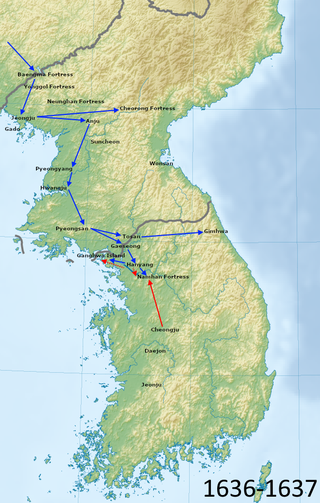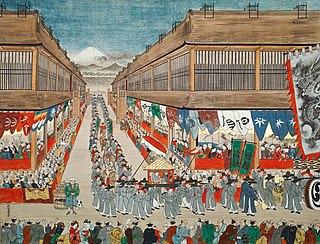During the 17th century, there were two Manchu invasions of Korea:
- Later Jin invasion of Joseon (1627)
- Qing invasion of Joseon (1636 – 1637)
During the 17th century, there were two Manchu invasions of Korea:
Sino-Japanese War most often refers to:

Admiral Yi Sun-sin was a Korean admiral and military general famed for his victories against the Japanese navy during the Imjin war in the Joseon Dynasty. Over the course of his career, Admiral Yi fought in at least 23 recorded naval engagements, all against the Japanese. In most of these battles, he was outnumbered and lacked necessary supplies. He nonetheless won battle after battle. His most famous victory occurred at the Battle of Myeongnyang, where despite being outnumbered 333 to 13, he managed to disable or destroy 31 Japanese warships without losing a single ship of his own. Yi died from a gunshot wound at the Battle of Noryang on 16 December 1598, the closing battle of the Imjin War.

The national flag of South Korea, also known as the Taegukgi and colloquially known as the flag of Korea, has three parts: a white rectangular background, a red and blue Taegeuk in its center, accompanied by four black trigrams, one in each corner. Flags similar to the current Taegeukgi were used as the national flag of Korea by the Joseon dynasty, the Korean Empire, as well as the Korean government-in-exile during Japanese rule. South Korea adopted the Taegukgi as its national flag when it gained independence from Japan on 15 August 1945.

Joseon, officially the Great Joseon, was the last dynastic kingdom of Korea, lasting just over 500 years. It was founded by Yi Seong-gye in July 1392 and replaced by the Korean Empire in October 1897. The kingdom was founded following the aftermath of the overthrow of Goryeo in what is today the city of Kaesong. Early on, Korea was retitled and the capital was relocated to modern-day Seoul. The kingdom's northernmost borders were expanded to the natural boundaries at the rivers of Amrok and Tuman through the subjugation of the Jurchens.
Joseon was a Korean kingdom between 1392 and 1897.

The Later Jin invasion of Joseon occurred in early 1627 when the Later Jin prince Amin led an invasion of the Joseon dynasty. The war ended after three months with the Later Jin establishing itself as sovereign tributary overlord over Joseon. However Joseon continued its relationship with the Ming dynasty and showed defiance in solidifying its tributary relationship with the Later Jin. It was followed by the Qing invasion of Joseon in 1636.

The Qing invasion of Joseon occurred in the winter of 1636 when the newly-established Qing dynasty invaded the Joseon dynasty, establishing the former's status as the hegemon in the Imperial Chinese Tributary System and formally severing Joseon's relationship with the Ming dynasty. The invasion was preceded by the Later Jin invasion of Joseon in 1627.

Hyujeong, also called Seosan Daesa was a Korean Seon master. As was common for monks in this time, he travelled from place to place, living in a succession of monasteries. Buddhist monks had been forced to keep a low profile since General Yi Seonggye had been forced to eject Buddhism from its state of total permeation of government in order to gain the support of Neo-Confucian scholar-officials to consolidate his position against his Buddhist political opponents when he overthrew Gongyang of Goryeo in 1392 to become King Taejo of Joseon.

The Veritable Records of the Joseon Dynasty are the annual records of Joseon, the last royal house to rule Korea. Kept from 1392 to 1865, the annals comprise 1,893 volumes and are thought to be the longest continual documentation of a single dynasty in the world. With the exception of two sillok compiled during the colonial era, they are the 151st national treasure of South Korea and listed in UNESCO's Memory of the World registry.

The Japanese invasions of Korea, commonly known as the Imjin War, involved two separate yet linked invasions: an initial invasion in 1592, a brief truce in 1596, and a second invasion in 1597. The conflict ended in 1598 with the withdrawal of Japanese forces from the Korean Peninsula after a military stalemate in Korea's southern provinces.

Korean ceramic history begins with the oldest earthenware from around 8000 BC. Throughout the history, the Korean peninsula has been home to lively, innovative, and sophisticated art making. Long period of stability have allowed for the establishment of spiritual traditions, and artisan technologies specific to the region. Korean ceramics in Neolithic period have a unique geometric patterns of sunshine, or it's decorated with twists. In Southern part of Korea, Mumun pottery were popular. Mumun togi used specific minerals to make colors of red and black. Korean pottery developed a distinct style of its own, with its own shapes, such as the moon jar or Buncheong sagi which is a new form between earthenware and porcelain, white clay inlay celadon of Goryeo, and later styles like minimalism that represents Korean Joseon philosophers' idea. Many talented Korean potters were captured and brought to Japan during the invasions of Korea, where they heavily contributed to advancing Japanese pottery. Arita ware, founded by Yi Sam-pyeong opened a new era of porcelain in Japan. Another Japanese representative porcelain, Satsuma ware was also founded by Dang-gil Shim and Pyeong-ui Park. 14th generation of Su-kwan Shim have been using the same name to his grandfather and father to honor they are originally Korean, 14th Su-kwan Shim is honorable citizen of Namwon, Korea.

Tsushima Island is an island of the Japanese archipelago situated in-between the Tsushima Strait and Korea Strait, approximately halfway between Kyushu and the Korean Peninsula. The main island of Tsushima, once a single island, was divided into two in 1671 by the Ōfunakoshiseto canal and into three in 1900 by the Manzekiseto canal. These canals were driven through isthmuses in the center of the island, forming "North Tsushima Island" (Kamino-shima) and "South Tsushima Island" (Shimono-shima). Tsushima also incorporates over 100 smaller islands, many tiny. The name Tsushima generally refers to all the islands of the Tsushima archipelago collectively. Administratively, Tsushima Island is in Nagasaki Prefecture.
The Ōei Invasion, also known as the Gihae Expedition, was a 1419 invasion from Joseon against wokou bases on Tsushima Island, which is located in the middle of the Tsushima Strait between the Korean Peninsula and Kyushu.
Injo of Joseon, born Yi Jong, was the sixteenth ruler of the Joseon Dynasty of Korea. He was the grandson of King Seonjo and son of Prince Jeongwon. He was the king during the Later Jin invasion of Joseon, in which Later Jin withdrew the armies after their demands were met. However, in the subsequent Qing invasion, King Injo surrendered in 1636, agreeing to the subjugating terms outlined by the Qing.
Horan is an Irish surname.

The Joseon Tongsinsa were goodwill missions sent intermittently, at the request of the resident Japanese authority, by Joseon dynasty Korea to Japan. The Korean noun identifies a specific type of diplomatic delegation and its chief envoys. From the Joseon diplomatic perspective, the formal description of a mission as a tongsinsa signified that relations were largely "normalized," as opposed to missions that were not called tongsinsa.
Border Defense Council of Joseon(비변사, 備邊司) is the supreme administrative organ since mid-Joseon whose other names were like Biguk or Joosa. The council took alternative initiative instead of Uijeongbu, State Council of Joseon, distinctively after the twice invasion from Japan and from Mongolians.

The Jingbirok, written in Hanmun, is a first hand account of the Imjin War written by high ranking Joseon scholar-official Ryu Seong-ryong. Party to high level decision making on the allied Ming-Joseon side and able to access all Joseon records, Ryu Seong-ryong's Jingbirok has become an invaluable source in the study of the conflict, and Chinese-Korean-Japanese relations. In 1969 the Jingbirok was listed as the 132nd of the National Treasures of South Korea.
Lee Ho (Korean: 이호) may refer to:
The Jingbirok: A Memoir of Imjin War is a South Korean historical drama television series. Labeled as "Special Project Epic Drama for 70th Anniversary of Korean Independence Day", it aired on KBS1 every Saturday and Sunday at 21:40 (KST) from February 14 to August 2, 2015.